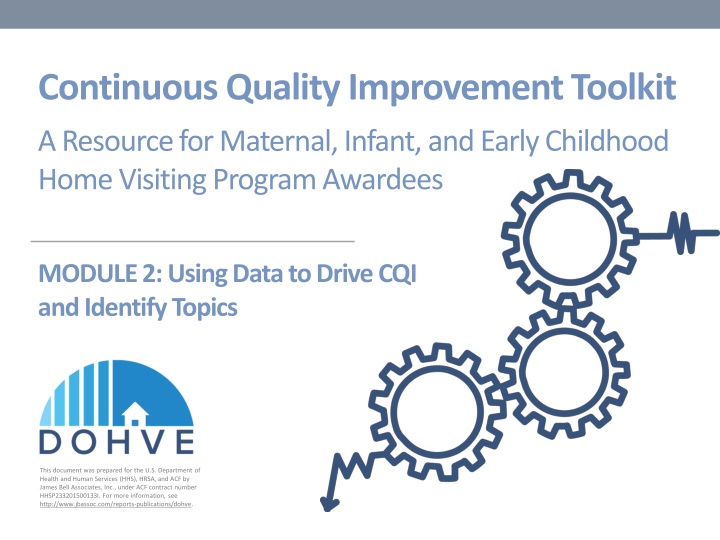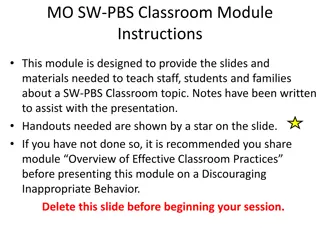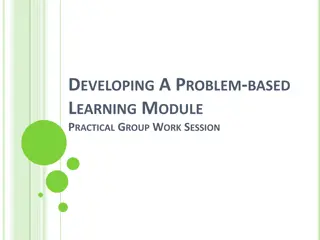
Harnessing Quality Data for Continuous Improvement in Home Visiting Programs
Discover how data plays a crucial role in driving continuous quality improvement initiatives for maternal, infant, and early childhood home visiting programs. Learn the importance of quality data, how to identify project topics, and effectively use data to enhance outcomes and services for families.
Download Presentation

Please find below an Image/Link to download the presentation.
The content on the website is provided AS IS for your information and personal use only. It may not be sold, licensed, or shared on other websites without obtaining consent from the author. If you encounter any issues during the download, it is possible that the publisher has removed the file from their server.
You are allowed to download the files provided on this website for personal or commercial use, subject to the condition that they are used lawfully. All files are the property of their respective owners.
The content on the website is provided AS IS for your information and personal use only. It may not be sold, licensed, or shared on other websites without obtaining consent from the author.
E N D
Presentation Transcript
Continuous Quality Improvement Toolkit A Resource for Maternal, Infant, and Early Childhood Home Visiting Program Awardees MODULE 2: Using Data to Drive CQI and Identify Topics This document was prepared for the U.S. Department of Health and Human Services (HHS), HRSA, and ACF by James Bell Associates, Inc., under ACF contract number HHSP233201500133I. For more information, see http://www.jbassoc.com/reports-publications/dohve.
CQI Training Overview 1 2 3 4 5 6 7 8 9 Introduction to CQI Using Data to Drive CQI and Identify Topics Creating the CQI Culture and Forming a Team Creating SMART Aims Understanding the PDSA Process & Measurement CQI Tools I: Process Maps CQI Tools II: Root Cause Analysis Tools CQI Tools III: Key Driver Diagrams Reliability Concepts and Sustaining Gains
Using Data to Drive CQI and Identify Topics: Learning Objectives Define quality data and importance of data in CQI Learn how to identify topics for CQI projects Understand how to use data to inform CQI work
Why is it Important to Use Data in CQI? Data are focused and objective measures of change in services and outcomes for families.
What are Quality Data? Complete all values are present Accessible available when required Relevant answers the proposed questions Accurate free from errors Reliable data are consistent as required
Collecting Quality Data Can you give an example of a time you collected data that were Incomplete Inaccessible Not relevant
How are Quality Data Collected? Standardization Appropriate tool selection Staff training Data management processes
Quality Data Drive Better Outcomes Improved Program Processes Effective Program Monitoring Quality Data Better Outcomes
Dont wait until the project is over to review your data and address data quality issues!
What is Your Role in Data Quality? Be comfortable with your data collection tools. Each staff member should know The purpose of the tool or data collection form How to administer the tool How to score tools and interpret the scores How to share results with families Specific protocol for entering/recording data
How to Identify a Topic? Review the data Elicit stakeholder input Align with strategic vision Consider feasibility
Using Change Concepts to Identify Topics Eliminate Waste Improve Workflow Available Home Visitors Change Work Environment Adapted from http://www.ihi.org/resources/Pages/Changes/ UsingChangeConceptsforImprovement.aspx
Using Change Concepts to Identify Topics (continued) Home Visitor/Family Interface Manage Time Error Proofing Focus on Service Adapted from http://www.ihi.org/resources/Pages/Changes/ UsingChangeConceptsforImprovement.aspx
Identifying CQI topics: Aim Statements 90% of moms that screened positive for depressive symptoms at intake will no longer screen positive after 6 months 90% of all depression screenings will be entered within 14 days of being collected OR
All improvement will require change, but not all change will result in an improvement. The Improvement Guide: A Practical Approach to Enhancing Organizational Performance by G.L. Langley, K.M. Nolan, T.W. Nolan, C.L. Norman, and L.P. San Francisco: Jossey-Bass Publishers, 2009.
Using Run Charts 35% 30% 25% 20% 15% 10% 5% 0% July August September November Average Target
Percentage of home visits where parents were asked if they had concerns abouttheir children s development or learning 99% 98% 96% 100% 78% 77% 74% 80% Question moved to HV form All HV, all families, every visit 60% 48% Reminder Sticker added to HV form 1 Team of HV, 1 day, 14 families 40% 19% 20% Reminder Sticker added to HV form 1 HV, 1 day, 4 families 0% Jan Feb Mar Apr May June July Aug Screening Rate Target
Activity: Developing Run Charts Cherryville Home Visiting Center identified increasing depression screening rates as its CQI topic. The following data reflect the depression screening rates for each month for the past year. Plot the screening data on the run chart on your worksheet. Month Percentage of Newly Enrolled Caregivers Screened 19 Month Percentage of Newly Enrolled Caregivers Screened 38 January July February 24 August 66 March 18 September 78 April 18 October 97 May 34 November 95 June 42 December 98
Cherryville Depression Screenings 98% 97% 95% 100% 78% 80% 66% What could have happened to explain this increase? 60% 42% 38% 34% 40% 24% What could have happened to explain this increase? 19% 18% 18% 20% 0% Jan Feb Mar Apr May June July Aug Sep Oct Nov Dec 22
Tips for Effective Measurement Plot data over time Seek usefulness Integrate measurement into the daily routine of a home visitor Use both qualitative and quantitative data Adapted from http://www.ihi.org/resources/Pages/HowtoImprove/ScienceofImprovementTipsforEffectiveMeasures.aspx
Remember... Data quality allows CQI teams to measure progress towards outcomes accurately. Reviewing data and using change concepts are useful in identifying topics for change strategies. Run charts or other data visualization techniques help monitor progress during a CQI project. 1. 2. 3.
Additional CQI Resources CQI Briefs: http://www.jbassoc.com/reports-publications/dohve Quality Improvement Toolbox: http://www.hrsa.gov/quality/toolbox/methodology/qualityimpr ovement/index.html
Disclaimer The purpose of the Design Options for Home Visiting Evaluation (DOHVE) is to provide research and evaluation support for the Maternal, Infant, and Early Childhood Home Visiting (MIECHV) Program. The project is funded by the Administration for Children and Families (ACF) in collaboration with the Health Resources and Services Administration (HRSA) under contract number HHSP233201500133I. This publication was developed by James Bell Associates on behalf of the U.S. Department of Health and Human Services (HHS), HRSA, and ACF. Contents are the sole responsibility of the authors and do not necessarily represent the official views of HHS, HRSA, or ACF.






















